The insignia of the Society of the Cincinnati was designed in 1783 by Pierre-Charles L’Enfant. Known as the Eagle, the Society’s insignia is a double-sided medal in the shape of the bald eagle, a distinctly American symbol that was chosen just a year earlier as the central figure of the Great Seal of the United States. With its down-turned wings, olive branches in both talons and depictions of the ancient Roman hero Lucius Quinctius Cincinnatus, the Society Eagle emphasizes the founding of a peaceful American republic and the return of its soldiers to their civilian lives.
Members wore their Eagles to parades, orations and other civic events, in addition to private Society meetings and gatherings. The Society insignia became, in part, a public symbol of the officers’ participation in the War for Independence and a reminder of the American republic’s ideals and origins. Benjamin Franklin—later elected an honorary member of the Pennsylvania branch of the Society—took note of the organization’s insignia in January 1784. In his now-famous letter expressing his preference for the turkey as a symbol of the United States, he objected to the choice of the eagle for the Great Seal and the Society of the Cincinnati insignia—“by no means a proper emblem for the brave and honest Cincinnati of America, who have driven all the Kingbirds from our Country.”
The first Eagles were made in early 1784 in Paris under L’Enfant’s direction, as he considered French craftsmen to be the only ones in the world skilled enough to produce the fine gold-and-enamel medals. L’Enfant contracted with Nicolas Jean Francastel and Claude Jean Autran Duval to make these first several hundred Eagles. American craftsmen soon began making their own versions of the Society insignia, which were sold to members in cities from Boston to Savannah.
The more than seventy Society Eagle insignias in the Institute’s collections document the variety in designs and makers over the years, especially in the founding era. Foremost among them is the Diamond Eagle, a jewel-encrusted insignia that French naval officers commissioned for George Washington in 1784 and became the badge of office of the Society’s president general.
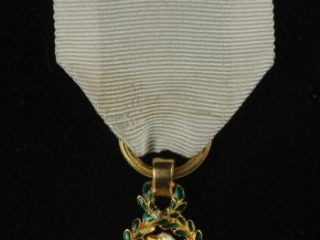
Society of the Cincinnati Eagle insignia owned by Louis François Bertrand du Pont d'Aubevoye, comte de Lauberdière
Nicolas Jean Francastel and Claude Jean Autran Duval, Paris
1784Museum Acquisitions Fund purchase, 2013
The first examples of the Society insignia were made in Paris in January 1784 for French members of the Society. Jewelers Francastel and Duval made forty-five small gold insignias, the first of which were distributed by the marquis de Lafayette at an organizing meeting of the French branch of the Society. This example was owned by the comte de Lauberdière, an aide-de-camp to General Rochambeau.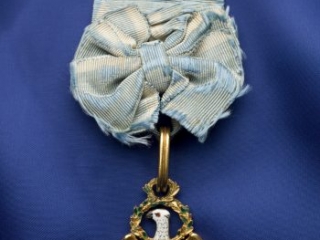
Society of the Cincinnati Eagle insignia owned by Tench Tilghman
Nicolas Jean Francastel and Claude Jean Autran Duval, Paris
1784Gift of Harrison Tilghman, Society of the Cincinnati of Maryland, 1953
George Washington, the first president general of the Society, purchased eight gold Society insignias to give to former aides-de-camp who joined the organization. He presented this one to Tench Tilghman of Maryland, to whom Washington entrusted the duty of delivering to Congress the Articles of Capitulation after the Siege of Yorktown. Tilghman's Eagle retains its original silk ribbon and metal clasp.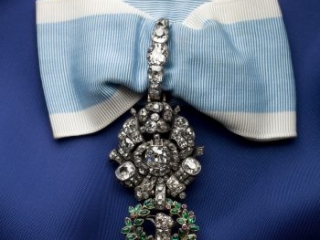
Diamond Eagle of the Society of the Cincinnati
Nicolas Jean Francastel and Claude Jean Autran Duval, Paris
1784Gift of Charles Cotesworth Pinckney, Society of the Cincinnati of the State of South Carolina, 1811
The Diamond Eagle, the badge of the office of the president general, was commissioned by French naval officers who served in the Revolutionary War as a gift for George Washington. Adorned with 198 diamonds, emeralds and rubies, the Diamond Eagle has been worn by every president general since Washington, including Alexander Hamilton, who succeeded Washington in the role.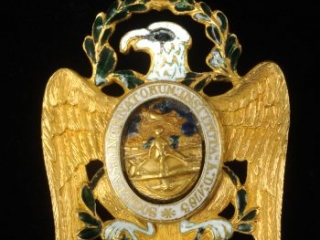
Society of the Cincinnati Eagle insignia owned by Richard Clough Anderson
Jeremiah Andrews, Philadelphia
ca. 1784-1791Gift of Isabel Anderson, 1938
Jeremiah Andrews, the first American craftsman to make the Society insignia, sold the Eagle to members from Philadelphia to Savannah beginning in late 1784. This gold example was owned by Richard Clough Anderson, an officer in the Virginia Continental Line and aide-de-camp to Lafayette.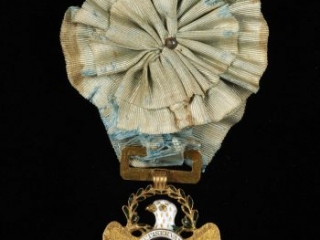
Society of the Cincinnati Eagle insignia owned by William Linn
John Cook, New York
1800Museum Acquisitions Fund purchase, 2013
The Reverend William Linn, who served as chaplain of the Fifth Pennsylvania Battalion during the Revolutionary War, was elected an honorary member of the New York Society the same day he delivered a funeral eulogy for George Washington to the group. Linn's gold Eagle retains its original silk ribbon and metal clasp.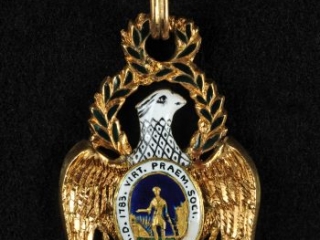
Society of the Cincinnati Eagle insignia
Probably Boston, Mass.
ca. 1795-1820The Society of the Cincinnati Collections
In the founding era, at least six different versions of the Eagle were made by American craftsmen, some of whose identities are not known. This gold example was probably made in Boston.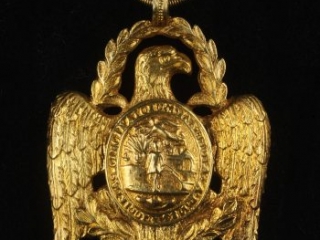
Society of the Cincinnati Eagle insignia commissioned by the Rhode Island Society
Attributed to Thomas Fletcher, Philadelphia
ca. 1821Gift of Gary E. Young, Society of the Cincinnati in the State of Virginia, 2014
The Rhode Island Society became the first state branch of the Society to commission an Eagle design in 1821. This plain gilt copper example is one of five early Rhode Island Society Eagles in the Institute's collections.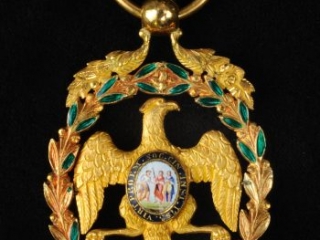
Replica of the Society of the Cincinnati Eagle insignia owned by Marie-Joseph-Paul-Yves-Roch-Gilbert du Motier, marquis de Lafayette
Paris, France
ca. 1830-1832Gift of the estate of Mabel S. Daveis, 1950
During Lafayette’s visit to Virginia in 1824, George Washington’s adopted granddaughter Eleanor (Nelly) Parke Custis Lewis presented Lafayette with a distinctive Society insignia Washington had owned. In 1830, Lafayette gave permission to Charles Stewart Daveis, a member of the Massachusetts branch of the Society, to have this replica made for Daveis to take with him back to America.